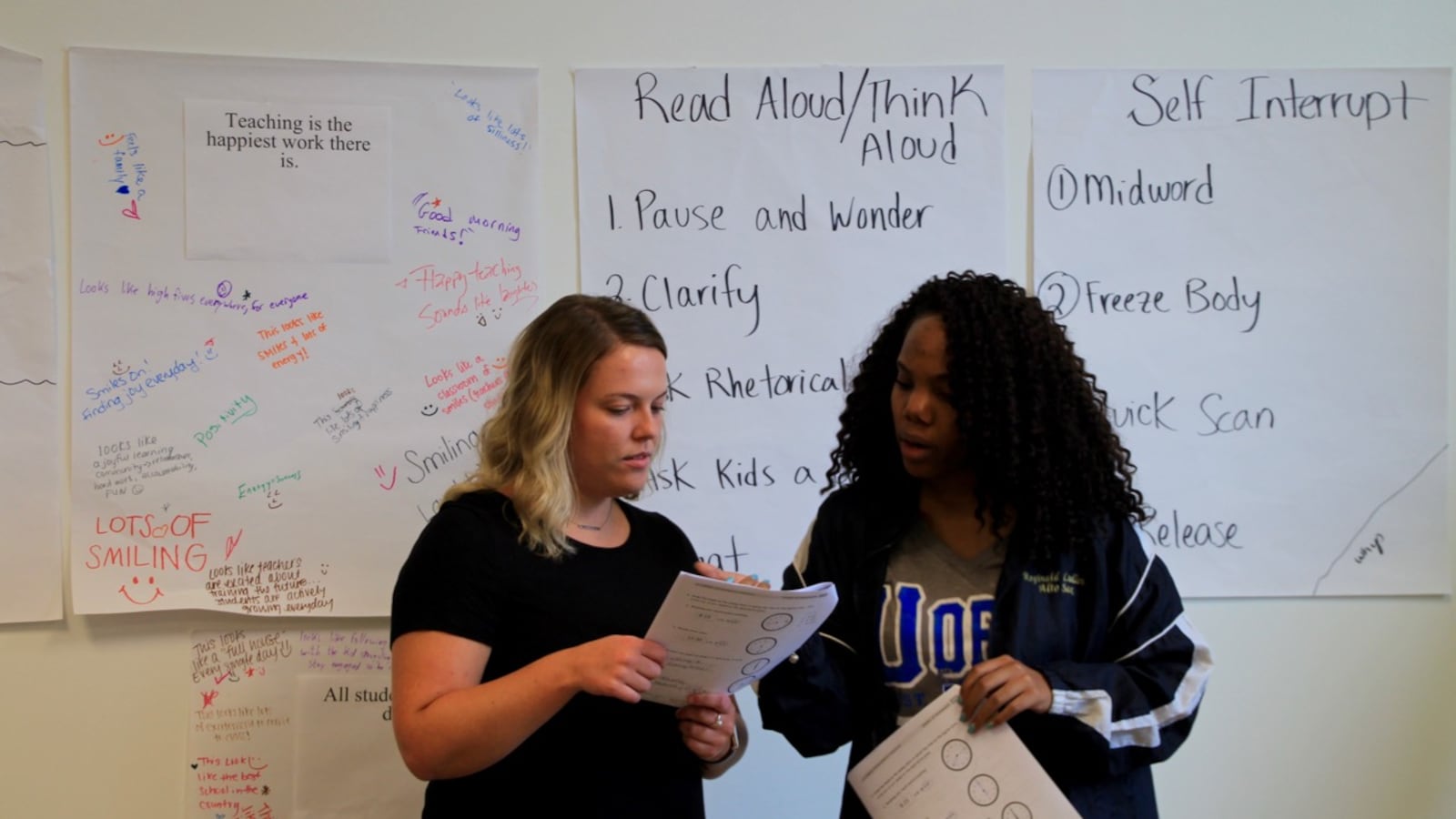Becoming a certified teacher in America usually means navigating a maze of university classes and certification tests — and paying for them.
The goal is a high-quality teaching force, and an array of powerful advocates have been pushing to “raise the bar” further. But the rules likely come with a hefty cost: a less diverse profession.
A Chalkbeat analysis has found that virtually every step in the common teacher certification process risks disproportionately excluding prospective teachers of color. The requirements for entering schools of education, passing teacher-prep exams, and a host of other factors each hit black and Hispanic prospective teachers hardest.
And while researchers have examined these steps independently, the results together show how multiple roadblocks make it harder for the teaching force to grow more diverse.
“What we know about the different components of certification certainly suggests that it reduces the diversity of the potential teacher pool,” said Dan Goldhaber, a professor at the University of Washington and an expert on teacher certification.
Today, 80 percent of America’s public school teachers are white. That figure has declined only modestly in the last 15 years, even as the share of students who are not white has grown sharply — and as recent research has shown that students of color benefit from having teachers of color.
Chalkbeat’s analysis doesn’t definitively prove that licensure rules hurt teacher diversity, since the consequences of changing or removing them are unclear. It’s also not clear how helpful these requirements are for improving teacher quality. Research has generally found a modest link between certification and teachers’ success in the classroom.
But as more states try to “raise the bar” to enter the teaching profession, it is clear that the brunt of tough certification rules are borne by teachers of color. Here’s how.
1. It starts with an undergraduate grade-point average.
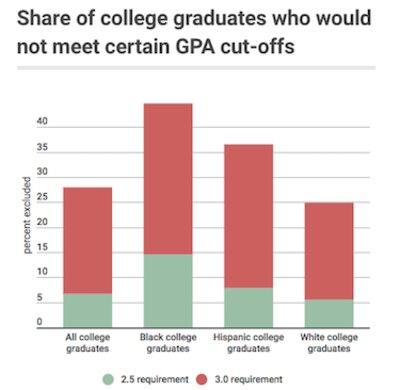
Thirty-four states have GPA requirements either for individuals entering teaching or for cohorts of students in teacher training programs. National accreditors have pushed education schools to adopt those requirements.
The most common requirement is a 3.0 GPA, which would exclude nearly half of black college graduates and over one-third of Hispanic college graduates, according to a 2012 federal report. (A note of caution: this data is somewhat old, covering students who graduated in the 2007–08 school year. There does not appear to be more recent comprehensive data.)
2. When they take traditional teaching exams, black and Hispanic candidates fail more often.
Virtually every state in the country requires teacher candidates to pass standardized tests, often a basic skills exam and specific content assessments. The modern incarnation of teacher competency tests began in the South in the 1970s, coinciding with extensive court efforts to integrate schools, and spread quickly; critics at the time said their purpose was to exclude black teachers.
Regardless of motives, it remains the case that pass rates on these tests are substantially lower, on average, for prospective teachers of color.
An analysis by the Education Testing Service, which produces the commonly used Praxis exams, found that candidates of color were dramatically more likely to fail the Praxis I, a basic skills test. Black test-takers were about 40 percent less likely to pass than white test-takers, and Hispanic candidates were about 20 percent less likely. Gaps were also seen between white and Asian-American and Native American test-takers.
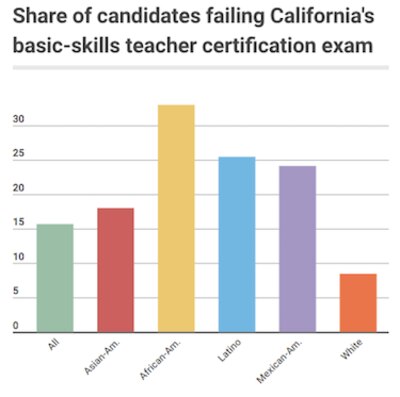
Every single Praxis II exam, which cover subjects from elementary instruction to chemistry, has a similar disparity.
That doesn’t necessarily mean the requirements are racially biased. Some say they simply reflect larger societal inequities.
“Those performance differences are not the results of bias in the test but rather a reflection of factors in society that lead to different educational opportunities,” said Christine Betanelli, an ETS spokesperson, who said extensive efforts are made to ensure tests are fair and free of bias.
State-specific exams exhibit similar trends. In California, according to data from 2010 to 2015, white candidates are much less likely to fail the basic academic skills exam.
Some states even hold teacher prep programs accountable for those passing rates. North Carolina, for instance, threatens sanctions for schools where fewer than 70 percent pass the Praxis. Three of the four schools that failed to meet that benchmark in consecutive years were historically black colleges and universities, according to recent data.
3. A new kind of test has shrunk the gaps, but black candidates continue to fail at higher rates.
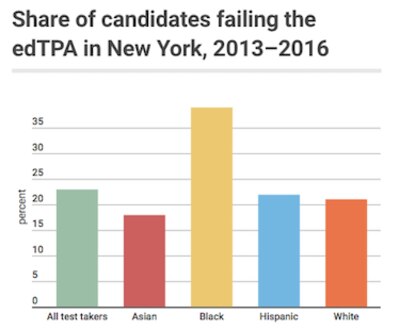
What many see as flaws of paper-and-pencil teacher exams — specifically, that they fail to measure teaching skills — have fueled the creation of assessments designed to judge teachers in action.
The most popular, the edTPA, has candidates submit a portfolio of work, including teaching videos. Twelve states and hundreds of teacher education programs use it.
A national report found that there was no difference in performance between Hispanic candidates and white candidates. But black candidates performed substantially worse than average. In New York, black test takers are nearly twice as likely to fail the edTPA as white or Hispanic candidates, according to the state.
However, the edTPA black–white disparity, while substantial, tends to be significantly smaller than the Praxis exams’ gaps. Andrea Whittaker, the national director for the edTPA, says a forthcoming report will show that differences between black and white candidate performance has shrunk even further.
4. All of those teaching exams cost a lot, especially if you have to retake them.
Another way certification exams may deter potential teachers of color — and others from low-income backgrounds — is through their cost, though no one appears to have quantified the effect.
Praxis exams range from $60 to $170. At $300, edTPA is substantially more expensive than traditional tests. In states like New York that require multiple exams, costs can quickly add up, and they become more substantial for those who have to retake an exam. (Some states, districts, and training programs subsidize these fees.)
5. Alternative pathways attract more teachers of color, but some states limit them.
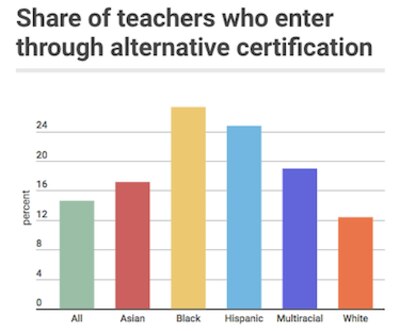
Prospective teachers anywhere in the country can get a teaching certificate at a university, usually accompanied by student teaching. The vast majority of states allow for alternative routes, often with substantially shorter training periods.
National data show that black and Hispanic teachers are about twice as likely as white teachers to have to been prepared through an alternative program. Teacher diversity might suffer in states with limited alternative routes, ones that maintain similar training requirements as traditional programs, or simply places where alternative options are scarce.
That’s what a 2009 study that compared the share of teachers of color relative to the adult population in all 50 states found. States with expansive alternative licensure options had much more diverse teaching corps than states with limited or no alternative certification.
Data sources and notes for graphs: GPA cut-offs, California basic skills exam, edTPA in New York, and alternative certification.


